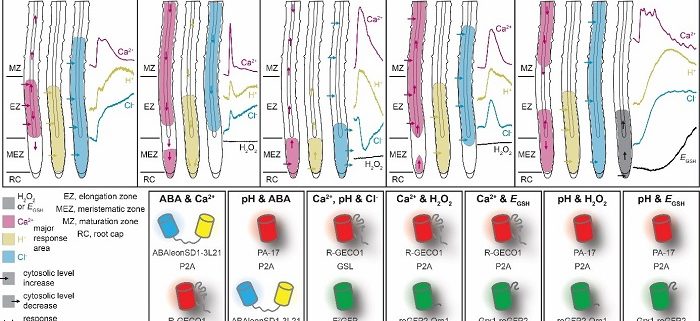2-in-1-GEFIs: Biosensors for two plant signals at one time
Waadt et al. use a suite of genetically encoded biosensors to monitor signaling compound concentration changes and how they overlap in time and space. Plant Cell https://doi.org/10.1105/tpc.19.00892
By Rainer Waadt
Background: To survive, plants need to sense the environment and adjust their growth and development according to the conditions they face. One part of the adjustment process is the translation of external signals into biochemical signals within plant cells. These biochemical signals are often encoded in concentration changes of signaling compounds, for example hormones, calcium (Ca2+), protons (H+) and reactive oxygen species (ROS). We were interested in where and when signaling compounds change their concentrations within root cells of Arabidopsis thaliana plants in response to external treatments. To measure these changes in intact and living plants, we were using genetically encoded fluorescent indicators (GEFIs) also known as “biosensors”. Upon binding to signaling compounds, GEFIs change their fluorescence properties that can be measured at a microscope.
Question: Measurements of signaling compounds in living plants is very important for our understanding about where, when and how plants respond to environmental changes. Therefore, we aimed to measure multiple signaling compounds in Arabidopsis roots and asked whether signaling compound concentration changes overlap in time and space in response to external treatments.
Findings: To answer our questions, we first developed seven 2-in-1-GEFIs that enable the analysis of two signaling compounds at the same time. Using the 2-in-1-GEFIs, we found that in roots of five-day-old cultured Arabidopsis thaliana plants, the drought hormone abscisic acid (ABA) had no effect on cellular Ca2+ and H+ levels. But in response to several treatments, increases of cellular Ca2+ concentrations overlapped in time and space with increases of H+ and anion concentrations. In addition, external treatments that induced Ca2+ signals had no strong effects on cellular levels of the ROS hydrogen peroxide (H2O2).
Next steps: As we did our experiments in wild-type Arabidopsis plants, the next steps are to cross 2-in-1-GEFI plants with Arabidopsis mutants that have problems with transporting signaling compounds across cellular membranes. Using 2-in-1-GEFI measurements in such mutants will help us to understand which transporter proteins are used for making the signals and how the signals influence each other.
Rainer Waadt, Philipp Köster, Zaida Andrés, Christian Waadt, Gabriele Bradamante, Konstantinos Lampou, Jörg Kudla, and Karin Schumacher. (2019). Dual-Reporting Transcriptionally Linked Genetically Encoded Fluorescent Indicators Resolve the Spatiotemporal Coordination of Cytosolic Abscisic Acid and Second Messenger Dynamics in Arabidopsis. Plant Cell. https://doi.org/10.1105/tpc.19.00892




